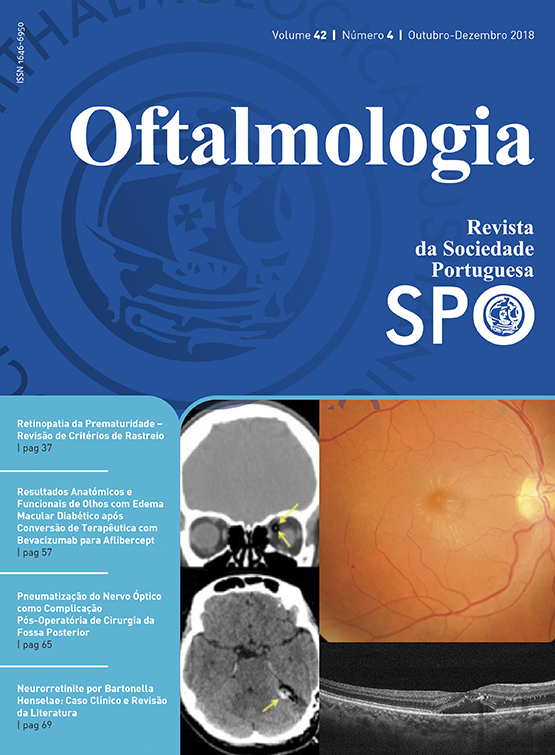TOMOGRAPHIC AND ANGIOGRAPHIC FEATURES OF DIABETIC RETINAL MICROANEURYSMS: A SIMULTANEOUS STUDY REPORT
DOI:
https://doi.org/10.48560/rspo.13684Palavras-chave:
Microaneurysms, Diabetic Retinopathy, Cystoid Spaces, Macular Edema, Optical Coherence Tomography, SD-OCT, Fluorescein Angiography, Angiographic LeakageResumo
PURPOSE - To correlate the morphological characteristics of diabetic retinal microaneurysms on spectral domain optical coherence tomography (SD-OCT) with their functional leakage status on fluorescein angiography (FA) in a simultaneous assessment..
METHODS – In this retrospective observational study, 88 retinal microaneurysms in 11 eyes of 6 type 2 diabetic adult patients with diabetic retinopathy (DR) (8 moderate non proliferative DR and 3 proliferative DR) were analyzed with simultaneous FA and SD-OCT imaging. Their morphological characteristics in SD-OCT, including shape, presence of a capsule-like structure, diameter, lumen reflectivity and the presence of nearby cysts were correlated with the leaking pattern (classified as absent, mild or intense).
RESULTS - The majority of the microaneurysms were oval in shape (86,4%), with no “capsule” (84.1%), with an heterogeneous lumen reflectivity (85.2%) and no associated cysts (65.9%). Their location in relation to the internal and external retinal boundaries (p=0.011) as well as nearby cysts (p<0.001) were correlated with angiographic leakage. No significant association was found between size, presence of a “capsule” and internal reflectivity on SD-OCT with the FA leakage status. Microaneurysms associated with cysts had larger vertical (p=0.001) and horizontal diameters (p<0.001).
CONCLUSIONS – A significant correlation was found between the presence of cystoid spaces in SD-OCT and detectable leakage on FA. In addition, cysts were found to be more frequent in the presence of larger microaneurysms, which may add some useful information regarding the pathophysiology of diabetic macular edema. The identification of high risk microaneurysms on SD OCT may help to establish a customized and more cost-effective strategy for follow-up and treatment in diabetic patients, without the need for invasive contrast imaging or OCT-angiography.
Downloads
Downloads
Publicado
Como Citar
Edição
Secção
Licença
Não se esqueça de fazer o download do ficheiro da Declaração de Responsabilidade Autoral e Autorização para Publicação e de Conflito de Interesses
O artigo apenas poderá ser submetido com esse dois documentos.
Para obter o ficheiro da Declaração de Responsabilidade Autoral, clique aqui
Para obter o ficheiro de Conflito de Interesses, clique aqui





